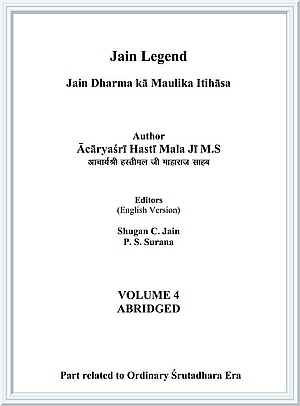The extremely lengthy history of Jainism starting from the coalition time of Bhogayuga (period of enjoyment) and Karmayuga (period of effort for enjoyment) up to V.N. 1475 has been discussed in the first three parts of this series in an abridged and simple form. The period ranging from V.N. 1476 to 2000 has been compiled in this part. Following the method adopted by Ācāryaśrī in this part too, along with the history of Jainism, we have presented the contemporary social and political scenario of the period concerned.
The history of Jainism, starting from the first Tīrthaṃkara Vṛṣabhadeva to the last Tīrthaṃkara omniscient Lord Mahāvīra, had been compiled in the first part of this series. The contemporary social and political conditions of that period were also described in brief. This period, i.e. the Tīrthaṃkara period is considered as the Golden age in the history of Jain religion.
The second part deals with the history of Jainism from the time of liberation of Lord Mahāvīra to V.N. 1000. In it, the political and social conditions prevalent in India during those 1000 years have also been discussed in a chronological order. This period is classified under four headings:
| Omniscient period: | |
| Period of knower of: | -14 prior canons; |
| -10 prior canons; | |
| -Ordinary knower of Scriptures. |
The four-fold religious order of Lord Mahāvīra remained united and continued its course untainted, like a rivulet, in spite of a few stray incidents during the time of Ārya Mahāgiri and Ārya Suhastī approximately in the 4th decade of the third century V.N. resulting in the trifurcation of unified congregation into Śvetāmbara, Digambara and Yāpanīya sects and also the inception of lax-code of conduct by the default Temple dweller monks. The four-fold religious order of Lord Mahāvīra also carried out welfare activities and uplifted the people by preaching and inspiring them to follow scripture-based right doctrines and way of living.
The third part discusses the date of origin of Bhaṭṭāraka (administrator monks) sect of Digambar tradition, the soul-stirring story related to its origin and its growth. While doing so, the most significant facts are also brought into light, of which all the contemporary Jain congregations, the scholars of those congregations and even the research scholars are unaware of.
The details provided in this part about the founders of Bhaṭṭāraka tradition - Ācārya Māghanandi, Gaṇḍarāditya, the King of Śilāhāra dynasty of Kolhapur, and Nimbadeva, his Commander-in-Chief are based on the information given in the five rock inscriptions obtained from the archaeological department of Kolhapur.
This part particularly brings into light the marvelling brilliance of Māghanandī, the founder of Bhaṭṭāraka tradition. He firmly resolved to restore Jainism to its original glory which went into oblivion due to lack of pure monks and followers. For this purpose he followed the propagation policy of Ādi Śaṃkarācārya and established 25 Jain seats (pītha) at crucial centres places of India. Thus he brought in a new awakening, zeal and stream of consciousness in Jain world.
Even the Yāpanīya congregation of Lord Mahāvīra, which involved in the preaching and propagation of Jain doctrines and wielded its power and influence from early 7th century V.N. to 20th century V.N. and which has lost its existence in time, has been detailed in this part.
Ācārya Siṃha Nandī of Yāpanīya Congregation established Gaṃga dynasty in Kolhapur and paved the way for the growth of Jain religion. The Gaṃga dynasty patronised the Jain religion faithfully for about 900 years and contributed actively towards its enrichment. The most unique and significant feature of this dynasty, founded by an ācārya of Yāpanīya Congregation is that, right from the first king Daḍiga and Mādhava to the last and 28th king Satyavākya, most of its kings were followers of Jainism.
The reasons that led to the decline of Jain religion are also discussed succinctly and clearly so that the monks and followers of contemporary Jain Congregations and of future generations will firmly resolve not to repeat the mistakes and will always direct their efforts towards the all-round development of the religious order of Lord Mahāvīra.
The greatest significance of this volume lies in the fact that it brought into light 700 years of Jain history - from 1001 to 1700 V.N. regarding which the research scholars, writers and erudite scholars expressed their inability to detail and remarked, "It is a dark age in Jain history, which disappeared in the abyss of oblivion." We are fortunate enough to lay our hands on related information and are passing the same onto our readers. As a result out of the 700 years of that Dark Age, nearly 850 pages were used only to describe 475 years of history. Hence we ventured to present the history of remaining 225 years in this fourth volume.
In this fourth part of our historical series we tried to bring out the historical events that took place during those 225 years.
 Acharya Hasti Mala
Acharya Hasti Mala
